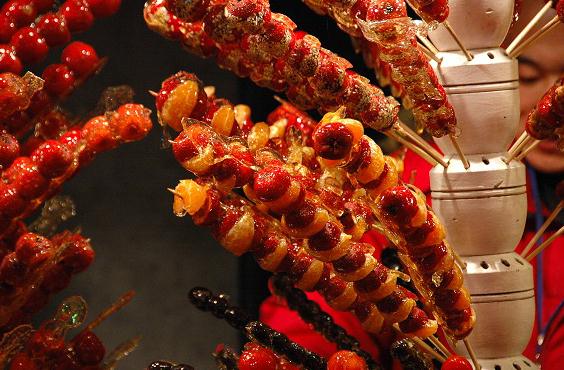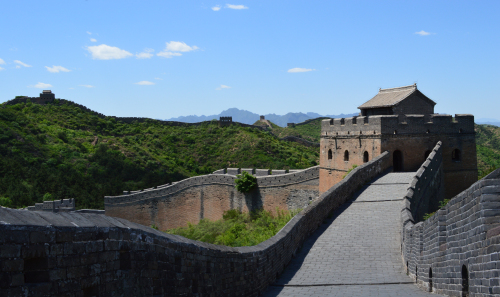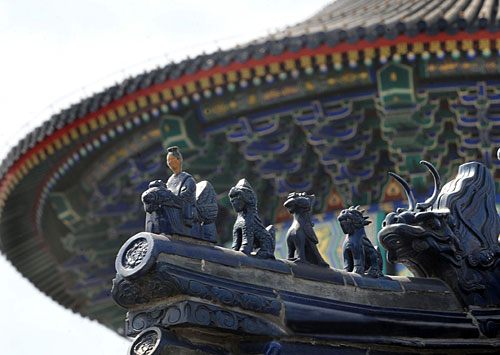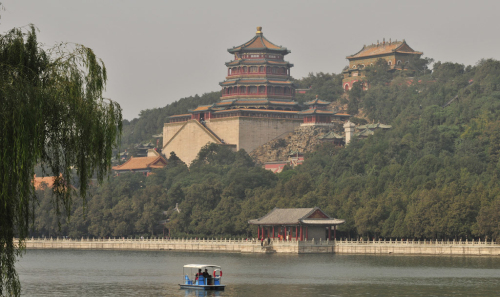| Day 1 Beijing ( ) |
Upon your arrival at the Beijing airport, your local guide will meet you and escort you to your hotel. The rest of the day is yours to relax and recover from jetlag.
Or you can sample some local snacks, select souvenirs and experience local life of Beijingner at Wangfujing Street. Or you can catch a glimpse of the nightlife of Beijingner at Sanlitun Bar Street.
|
Wangfujing Streeet | It is the grandest shopping area in Beijing, congested with modern shopping malls, such as the Oriental Plaza, Wangfujing Department Store, etc. It is also home to a wealth of hotels and specialty shops. Around is an afflicted snack street where you can enjoy the most authentic Beijing snacks. |
|
 |
| [ Optional ] Lao She Tea House: Lao She Tea House is one of Beijing's most famous tea house, and has been visited by a number of well-known politicians. It is a wonderful entertainment house with short shows by comedians, singers, musicians, acrobats and opera performers. |
|
| Day 2 Beijing ( B,L ) |
Hiking Route: Simatai West to Jinshanling (3 hours, 5 kilometers)
Pick-up from your hotel at 8:00am and then drive to Simatai West. You will start to hike around 10:30am. It’s a 3-hour hiking (about 5 kilometers) with jaw-dropping scenery from Simatai West to Jinshanling Great Wall and an amazing way to see the Great Wall in a more original, less restored state. Also Very few other visitors will make you feel that you have the place to yourself. After the hiking, you will be rewarded with a delicious lunch at a local farmer’s restaurant and then return to your hotel.
Good point for self-funded activity: The well-known Beijing Roast Duck for dinner. |
Jinshanling Great Wall | According to historical records, the construction of this section of the wall was begun in 1571,part of the 1,000-kilometer-long section of the wall between the Shanhai Pass in the east and Changping County in the west, which was the result of cooperation between two famous Ming generals. |
|
 |
| [ Optional ] Simatai Great Wall: Simatai located at the boundary between Gubeikou Town,130 km away from Beijing, and Luanping County,Hebei Province. The 19-kilometre-long wall of Simatai began its construction in 1368, with its unique design. Its 35 watchtowers are original structured and varied in form. |
|
| Day 3 Beijing ( B,L ) |
On this day, you'll stroll around the massive Tiananmen Square first after breakfast. It is the biggest Square in the world, always filled with sightseers and kite-flyers. Then proceed to the splendid Forbidden City, the imperial palace of the emperors of the Ming and Qing Dynasties.
Afterwards, you’ll be on a visit to the Temple of Heaven, where Chinese Ming and Qing emperors worshipped heaven and prayed for peace and harvest. Now it’s the most popular destination for locals and visitors, always full of groups practicing Tai Chi. Then proceed to explore the Beijing Hutong by rickshaw to learn more about the life and culture of the ordinary Beijinger.
Good point for self-funded activity: Appreciate the Chinese Kung Fu Show in the evening, presenting you a visual feast. |
Temple of Heaven | It was the place where the Emperor of the Ming and Qing dynasties would worship heaven and pray for good harvests. Built first in 1420, the Temple of Heaven is a precious example of China 's ancient architectural art and the largest design for worshipping heaven in the world. | Tian An Men Square | As the largest city plaza in the world, it is of great cultural significance for its seeing of several key events in Chinese history. Today here are always sightseers and kite-flyers. Most visit at dawn or dusk to see the flag raising and lowering conducted by the PLA. | Hutong Tour by Rickshaw | Hutongs are small alleyways where people live together in communities of homes packed into a small area,just like a museum of Beijing's folk customs. Exploring Hutongs by rickshaw can find the residents playing Chinese chess, Mahjong,etc. | Forbidden City | For almost 500 years, the Forbidden City served as the home of 24 Emperors and their households, and the ceremonial and political center of the Chinese imperial government. It was listed by UNESCO as a World Cultural Heritage Site in 1987. |
|
 |
| [ Optional ] Peking Opera: With a history of 160 years, Peking Opera, extolled as “Oriental Opera”, is representative of all operas in China. Full of Chinese cultural traditions and tidbits, the opera presents the audience with touching stories, beautiful paintings, exquisite costumes, graceful gestures and martial arts. |
|
| Day 4 Beijing ( B,L ) |
After breakfast, head to the magnificent Summer Palace. It boasts of elaborate design of long corridor, palace hall, temple and arch bridge in addition to a very pretty lake.
After the tour, you will be transferred to the airport for your flight to next destination or back to home. |
Summer Palace | The Summer Palace deserves your visit to her exquisite buildings, long corridor, and beautiful bridges. Her shoreline pathway makes an excellent run or walk for you. It was a luxurious imperial garden for royal families to rest and entertain in Chinese Qing Dynasty. |
|
 |
| [ Optional ] Kungfu show: The splendid Kung Fu show, running daily in Red Theater of Beijing shows you an authentic Kung Fu on the spot, which combining story-telling, acrobatics to celebrate the philosophy and skill of martial airs. You enjoy the opportunity to contact performers directly after the show or to learn Kung Fu from them! |
|